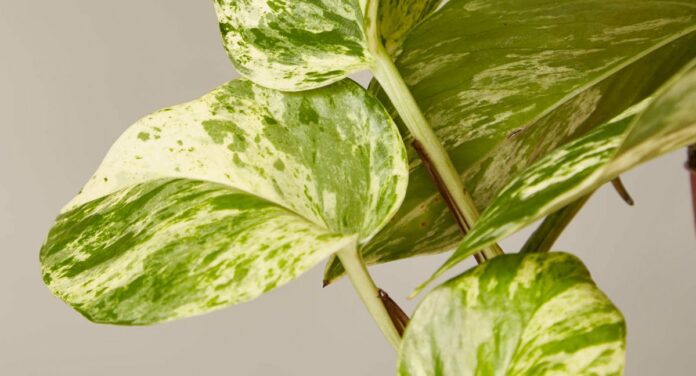If you’re looking to spruce up your apartment/home/workspace/you name it, the Pothos (Epipremnum aureum) plant is the way to go. Known as one of the easiest indoor plants to care for, this durable green beauty is basically fool-proof, even for beginners. Pothos is forgiving of neglect, virtually pest and disease-free, and tolerant of low light, making it a good choice for darker rooms and offices. Best of all, Pothos is one of the most popular houseplants for improving indoor air quality, as they naturally remove common household toxins from the air. This living air purifier with heart-shaped leaves is a beautiful AND healthy addition to your space.
Ready to make Pothos plants part of your family? Read on to learn how to make this lovely plant into the climbing garden of your dreams and check out this article on where to buy them!
View this post on Instagram
Tips To Grow Your Pothos
Where to grow: Place your Pothos near a window that receives bright, but indirect, light. Don’t place the pant right near the opening of a window, so you can avoid cold drafts.
Temperature and humidity: Pothos should be kept at an ideal temperature range between 60-80 degrees F. While they prefer high humidity similar to their native habitat of Southeastern Asia, Pothos is tolerant of average or dry air. Pothos will benefit from additional air moisture, such as misting or a room humidifier, during winter when indoor air is drier.
Soil type: Grow your Pothos plant in high-quality, well-draining potting soil, preferably with a slightly acidic pH of 6.1 to 6.5.
Pot requirements: Plant in a container one or two inches wider than the root ball with adequate drainage holes.
Propagation: Pothos is easily propagated (or reproduced) through stem cuttings. Cut stems six inches long just below a leaf node and place them in water. Roots will develop over a month or two. Change water every 2-3 weeks. Plant well-rooted cuttings in fresh potting soil.
Try this: Grow multiple stems in the same pot for the lushest, most spreadable growth.
How To Care For Your Pothos
Once your babies are planted, follow these tips to ensure they grow to their fullest potential:
Watering: Water your Pothos when the top 50% of the soil is dry; overwatering can cause root rot and yellow leaves. Discard excess water from the saucer underneath the pot so that plants are not sitting in water.
Fertilizing: Pothos are light feeders. Apply a liquid houseplant fertilizer every 1-3 months to keep plants looking healthy.
Pruning: Plants can be kept more compact or allowed to sprawl. Trim back long stems to keep plants full and bushy. Bare stems can be cut back to the soil level to encourage new branches to sprout. Looking for a climbing wall of lush vines? Allow plants to grow naturally, AKA no pruning.
Cleaning: Wipe leaves with a damp cloth every few weeks to keep the foliage looking fresh.
View this post on Instagram
Ways To Display Your Pothos
Once you decide on the look you’re going for, how best to display your pothos depends on how it is trained.
- Pothos can be kept compact and bushy, or allowed to develop as a trailing plant.
- Grow a trailing plant in a hanging basket and allow the foliage to cascade for an elegant display. Place in a bedroom, living room, or office to enjoy the benefits of air purification.
- Train a vining form up a vertical support such as driftwood, bark, a small trellis, or pole for a natural rain forest effect.
- Allow a vining form to sprawl horizontally along a tabletop, fireplace mantel, or bookshelf for a gentle, homey touch.
- Long runners can be trained along a wall or window frame, the branches secured with small cup hooks. This can give the appearance of fusing the indoors with nature.
- Feature a bushy type in a decorative pot as a coffee table accent.
- Place a trailing or bushy form on a shelf or hanger in a bathroom where it will thrive on the increased humidity and warmth from showers and baths.
View this post on Instagram
Troubleshooting
While Pothos have few insect or disease problems, here are some things to look out for:
Brown or yellow leaves: If older leaves are brown or yellow while new growth looks fine, this can be an indication of under watering or over watering. Trim back affected stems to the base of the plant to encourage new growth. Increase watering if you notice dry spells.
Loss of foliage color: Fading color is likely due to low light. Move to a brighter location.
Pale or brown leaves: This may be a sign that plants are getting too much light. Move to a location with less light.
Blackened leaves or stems or sudden plant collapse: Possibly a sign of overwatering and root rot. Cut off affected branches. Allow soil to completely dry out and new roots to develop. In severe cases, plants may not recover.
Pests: Wipe affected areas with a cotton ball dipped in 70% rubbing alcohol, or apply insecticidal soap. If the soil stays too wet over a period of time, it may attract fungus gnats. Allow soil to dry out between waterings to deter gnats.
Toxicity: All parts of the Pothos plant are mildly to moderately poisonous if ingested by pets or children. keep out of reach of children, and don’t get one at all if you have pets.
View this post on Instagram
Need some Pothos wall inspo to grow the climbing garden of your dreams? Check out these plant-friendly Instagram accounts:
Robin Shack is a freelance writer and editor. Her work has appeared in the Los Angeles Times, Amazon.com, Lagunasalt.com and sainteden.com



